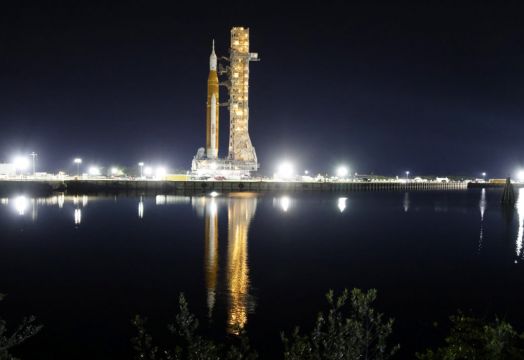Nasa’s new moon rocket arrived at the launch pad on Wednesday ahead of its debut flight in less than two weeks.
The 322ft rocket emerged from its mammoth hangar late on Tuesday, drawing crowds of Kennedy Space Centre workers.
It took nearly 10 hours for the rocket to make the four-mile trip to the pad at Cape Canaveral in Florida, pulling up at sunrise.
Nasa is aiming for an August 29 lift-off for the lunar test flight.

No-one will be inside the crew capsule atop the rocket, just three mannequins – test dummies swarming with sensors to measure radiation and vibration.
The capsule will fly around the moon in a distant orbit for a couple weeks, before heading back for a splashdown in the Pacific.
The entire flight should last six weeks.
The flight is the first moonshot in Nasa’s Artemis programme.

The space agency is aiming for a lunar-orbiting flight with astronauts in two years and a lunar landing by a human crew as early as 2025.
That is much later than Nasa anticipated when it established the programme more than a decade ago, as the space shuttle fleet retired.
The years of delays have added billions of pounds to the cost.
Nasa’s new SLS moon rocket, short for Space Launch System, is 41ft shorter than the Saturn V rockets used during Apollo half a century ago.
See more images of the #Artemis I @NASA_SLS rocket and @NASA_Orion spacecraft as they arrived at Launch Pad 39B this morning. 📷➡️ https://t.co/cTEfEpR4DT pic.twitter.com/MQUci1Tv6Q
Advertisement— NASA HQ PHOTO (@nasahqphoto) August 17, 2022
But it is more powerful, using a core stage and twin strap-on boosters, similar to the ones used for the space shuttles.
“When you look at the rocket, it almost looks retro. It looks like we’re looking back toward the Saturn V,” Nasa administrator Bill Nelson said this month.
“But it’s a totally different, new, highly sophisticated, more sophisticated rocket and spacecraft.”
Twenty-four astronauts flew to the moon during Apollo, 12 of them landing on it from 1969 to 1972.
Around 7:30am EDT the @NASA_SLS rocket and @NASA_Orion spacecraft for the #Artemis I mission arrived atop Launch Complex 39B after a nearly 10-hour journey from the Vehicle Assembly Building.
Learn more: https://t.co/qlRycMOmmA pic.twitter.com/tMxWB6uX9B— NASA's Kennedy Space Center (@NASAKennedy) August 17, 2022
The space agency wants a more diverse team and more sustained effort under Artemis, named after Apollo’s mythological twin sister.
“I want to underscore that this is a test flight,” Mr Nelson said. “It’s just the beginning.”
This was the rocket’s third trip to the pad.
A countdown test in April was marred by fuel leaks and other equipment trouble, forcing Nasa to return the rocket to the hangar for repairs.
The dress rehearsal was repeated at the pad in June, with improved results.







